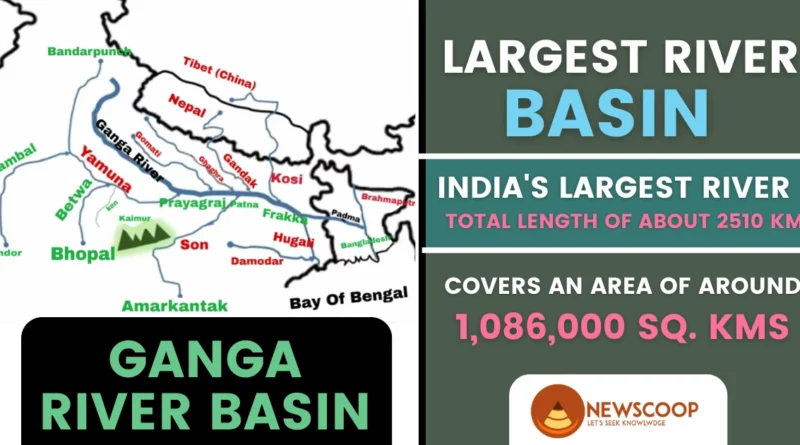Largest River Basin in India: In Detail | 100%
India is home to some of the world’s largest and most diverse river basins. A river basin is a land area drained by a river and its tributaries. The country’s rich and varied topography, combined with its monsoon climate, has resulted in the formation of numerous river systems.
These rivers are essential for the survival of the Indian population, supporting agriculture, fisheries, and a range of other industries. In this article, we will explore the largest river basins in India, their characteristics, and their importance to the country’s economy and culture.
Largest River Basin in India
The following are the largest river basins in India:
- Ganges – 1.1 million square kilometers (Largest)
- Brahmaputra – 580,000 square kilometers
- Indus – 320,000 square kilometers
- Godavari – 312,000 square kilometers
Here is a table comparing the largest river basins in India:
| River Basin | Area (square kilometers) | States/Countries | Major Tributaries | Importance |
|---|---|---|---|---|
| Ganges | 1.1 million | Uttar Pradesh, Bihar, West Bengal, Uttarakhand | Yamuna, Ghaghara, Gandak, Kosi | Sacred to Hindus, Crucial agricultural area, Facing challenges such as pollution and water scarcity |
| Brahmaputra | 580,000 | India, China, Bhutan, Bangladesh | Subansiri, Siang, Lohit | Sacred to Hindus, Crucial agricultural area, Faces challenges such as pollution and water scarcity |
| Godavari | 312,000 | Maharashtra, Telangana, Andhra Pradesh, Chhattisgarh | Manjira, Penganga, Wardha | Important agricultural area, Provides water for drinking, irrigation, and industrial purposes, Facing challenges such as pollution and water scarcity |
| Indus | 320,000 | India, Pakistan, China, Afghanistan | Jhelum, Satluj, Chenab, Ravi | Essential for agriculture and hydroelectric power, Facing challenges such as water scarcity and pollution, Prone to natural disasters such as floods and landslides |
1. The Ganges River Basin
The Ganges River is the longest river in India, and its basin is the largest in the country. It spans over 1.1 million square kilometers, covering several states including Uttar Pradesh, Bihar, West Bengal, and Uttarakhand. The Ganges basin is also home to several tributaries, including the Yamuna, Ghaghara, Gandak, and Kosi rivers. The river system is fed by the monsoon rains, which account for 80% of its annual water supply.
The Ganges basin is one of the most densely populated areas in the world, with over 400 million people living in the region. The river is considered sacred by Hindus, who believe that bathing in its waters can wash away their sins. The basin is also a crucial agricultural area, with a significant portion of India’s crops grown in the fertile soils surrounding the river. The Ganges basin is facing numerous challenges, including pollution, climate change, and water scarcity.

2. The Brahmaputra River Basin
The Brahmaputra River basin is the second-largest river basin in India, covering over 580,000 square kilometers. The basin spans four countries, including India, China, Bhutan, and Bangladesh. The Brahmaputra River originates in Tibet and flows through the Indian states of Arunachal Pradesh and Assam, before joining the Ganges River in Bangladesh.

The Brahmaputra basin is home to several tributaries, including the Subansiri, Siang, and Lohit Rivers. The river system is essential for the region’s economy, providing irrigation water for agriculture, hydroelectric power, and transportation. However, the basin is also prone to natural disasters, such as floods and landslides, which can cause significant damage to the region.
3. The Indus River Basin
The Indus River basin is the third-largest river basin in India, covering over 320,000 square kilometers. The basin spans over several countries, including India, Pakistan, China, and Afghanistan. The Indus River originates in Tibet and flows through several Indian states, including Jammu and Kashmir, Himachal Pradesh, and Punjab, before entering Pakistan.
The Indus Basin is also home to several hydroelectric power plants, which generate a significant portion of the region’s electricity. The basin is facing several challenges, including water scarcity, pollution, and the impacts of climate change. The region is also prone to natural disasters such as floods and landslides, which can cause significant damage to infrastructure and livelihoods.

4. The Godavari River Basin
The Godavari River basin is the fourth-largest river basin in India, covering over 312,000 square kilometers. The river originates in Maharashtra and flows through several states, including Telangana, Andhra Pradesh, and Chhattisgarh, before emptying into the Bay of Bengal. The basin is home to several tributaries, including the Manjira, Penganga, and Wardha Rivers.
The Godavari basin is an essentially agricultural area, with a significant portion of the country’s rice grown in the region. The river system also provides water for drinking, irrigation, and industrial purposes. However, the basin is facing several challenges, including pollution and water scarcity, which can impact the region’s agricultural productivity and economic development.
Comparison of the Largest River Basins in India
While the Ganges, Brahmaputra, Godavari, and Indus river basins differ in size, location, and characteristics, they share many common features. All four river systems are essential for the region’s agriculture, providing irrigation water for crops such as rice, wheat, and sugarcane. The rivers are also vital for transportation, hydroelectric power, and industrial activities.
However, all four river basins are facing numerous challenges, including pollution, water scarcity, and the impacts of climate change. Rapid urbanization, industrialization, and population growth have put immense pressure on these river systems, threatening the sustainability of the region’s economy and environment.
Conclusion
The largest river basins in India are crucial for the survival of the country’s population and economy. The Ganges, Brahmaputra, Godavari, and Indus river basins provide water for drinking, irrigation, and industrial purposes, and support a range of economic activities.
However, these river systems are facing numerous challenges, including pollution, water scarcity, and the impacts of climate change.
To ensure the sustainability of these river basins, it is essential to implement effective water management and conservation strategies. These strategies should involve a range of stakeholders, including governments, civil society organizations, and local communities.
By working together, we can ensure that these critical river systems continue to support the region’s economic and social development for generations to come.
Thank You!
What is the largest river basin in India?
The largest river basin in India is the Ganges River basin, covering an area of 1.1 million square kilometers.
What are some of the major tributaries of the Ganges River?
Some of the major tributaries of the Ganges River include the Yamuna, Ghaghara, Gandak, and Kosi Rivers.

